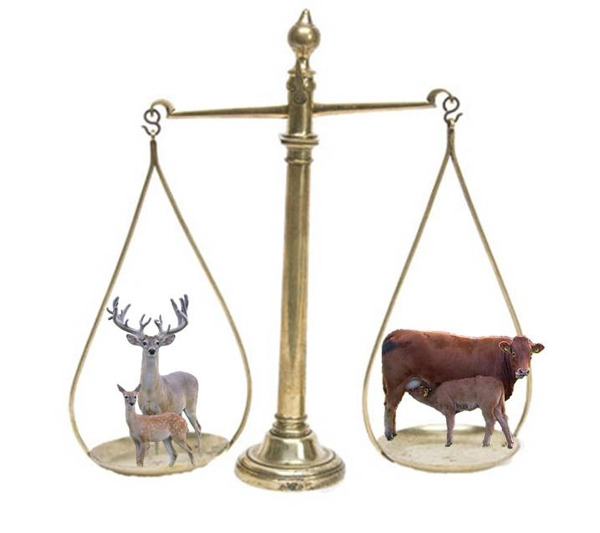
Livestock Management for Wildlife Production

Grazing management is the planned manipulation of livestock numbers and grazing intensities to increase food, cover, or improve structure in the habitat of selected species. Grazing management includes kind and class of livestock grazed, determination and adjustment of stocking rates, implementation of a grazing system that provides planned periodic rest for pastures by controlling grazing intensity and durations, and/or excluding livestock from sensitive areas to prevent trampling, allowing for vegetative recovery, or eliminating competition for food and cover. Planned deferments can be short or long term, depending on the conditions. Seasonal stocker operations may also be appropriate to manipulate habitat.
Livestock should be considered as “tools” that can be used to maintain good wildlife habitat. A well-planned livestock grazing system is one that allows adequate rest periods for plants to recover after grazing. Most domestic livestock are selective grazers and consume the most nutritious and palatable plants first. Whenever a plant is eaten, there is not only a reduction in top growth but also a reduction in root growth. This reduces the plant’s ability to rapidly regrow following defoliation. During the growing season, herbaceous plants need at least 30 to 60 days of rest to recover from grazing. Woody plants need as long as 4 to 6 months of rest to allow for regrowth. The recovery period depends upon the severity of defoliation, moisture conditions, and temperature.
Several livestock grazing methods and systems have been developed which provide adequate periods of rest and allow vegetative recovery. There are many variations of these systems and the land manager needs to select the one that fits his particular situation. Some commonly used deferred-rotation grazing systems are: Three pasture/one herd rotation, four pasture/one herd rotation, high intensity/low frequency, short duration, and four pasture/three herd rotation. Regardless of the type of deferred-rotation grazing system used, the length of time that an individual pasture should be grazed and the length of time that it would need to be rested before being grazed again would be dependent on the size of the pasture, its grazing capacity, the time of year (growing season versus non-growing season), the amount of rainfall received since being grazed, and the class of livestock. Grazing schedules and livestock stocking rates for pastures within a grazing system need to be flexible and continually re-evaluated based on rainfall patterns, seasons of the year, and the local range conditions. Knowing how long to graze and how long to rest is more an art than a science, dependent more on environmental factors and the on-site conditions than on the calendar.
Determining cattle stocking rates in can be tricky. As mentioned earlier, the quality and quantity of forage and rainfall are most important considerations; however, so is the class of livestock, soil and brush types, and past and current condition of the range. For optimum wildlife production, however, any cattle stocking rate determination should fall on the conservative side of things. Cattle are a great compliment to wildlife management when incorporated correctly.
All photo and content herein is copyrighted property of Spring Creek Outdoors, LLC and may not be copied/reproduced or otherwise used in any way without express written permission from Spring Creek Outdoors, LLC. All rights reserved.
Posted in: Land Management
